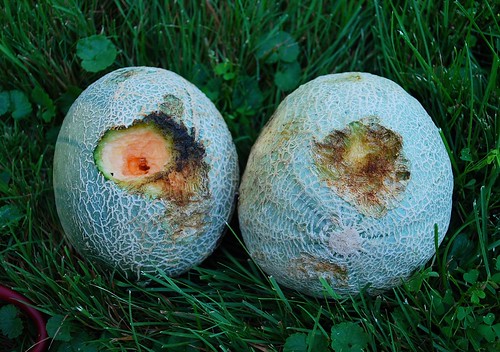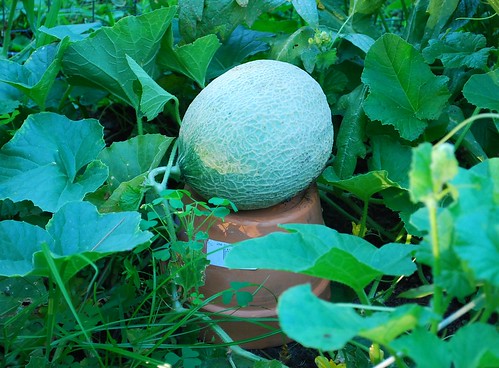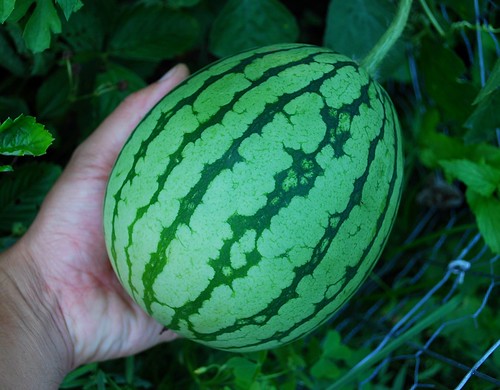
That's it. I'm growing all of my melons on trellises next year. It's so infuriating having to compost these destroyed Athena cantaloupes. I don't know what I was thinking growing them on the ground again this year, especially since I had issues with mice eating my watermelons last year. Never again.

The only thing I could think of to do to protect the remaining melons was to elevate them. I don't know if this will help but I can' think of another solution.

On the bright side, I had a couple of fruit set on my Sunshine watermelon vines. (And yes, I am elevating this baby too.) I was beginning to worry as my Blacktail Mountain watermelons began setting fruit weeks ago. This baby is growing like crazy unlike my Blacktails, which are stalling at the moment. I think I'll side-dress them with some more compost and organic fertilizer to see if that will them fatten them up.






Oh, I am so sorry that your melons were eaten! That is the worst feeling for a gardener. The watermelon looks great!
ReplyDeleteYou might try wrapping each melon in the fabric used for floaring row cover - aka remay. I've found that a physical barrier is often the only rodent deterrent that works and even that is no guarantee. I also set numerous rat and mouse traps (to get the baby rats) throughout the garden in the evening (and unset them in the morning to avoid catching birds) .
ReplyDeleteDang, I know what you are going through, it is SO FRUSTRATING. Good luck for your melon harvest.
That's floaTing row cover - can't type well on an iPad...
ReplyDeleteHow disappointing! I didn't have success with watermelons last year but will give them another try this year..maybe over a trellis to keep them off the ground.
ReplyDeleteOMG.....seems like those mice are having a party in your garden...nevertheless, nice garden u have there..keep up the good job! :)
ReplyDeleteVery annoying! Unfortunately I don't think trellises will solve the problem as mice and rats will easily be able to climb the trellis and vines. Some kind of physical barrier might be necessary combined with traps.
ReplyDeleteOh no! I have my cantaloupe trellised but not my watermelons. I just didn't get around to it. I think that I might put some netting over my watermelon plants just in case.
ReplyDeleteJust terrible!- We know how you feel, the squirrels dug up all our broad bean seedlings, so sad...
ReplyDeleteWe've tried to barricade the new ones with a mesh of twigs and sticks, not very attractive, but if it'll give them a chance to grow, its worth a try!
Those melon loving jerks! And such beautiful melons! I hope you get the problem under control... At least you have fruit setting though!
ReplyDeleteOh how terrible. Those look about ripe too. I hope elevating them works.
ReplyDeleteThat's what I was thinking, too, unfortunately. Mice can climb so I don't think trellises are the answer. I had thought perhaps hardware cloth or something similar, but probably Michelle's idea is better. I'm not familiar with the floating row cover material.
ReplyDeleteAnother possibility might be the netting that keeps birds out of fruit trees and bushes.
While I haven't tried melons yet, I do feel your frustration. Good luck with it, Thomas!
Wow, that is really a bummer. But thanks for posting about it. I am learning a lot.
ReplyDeleteBTW, does picking a little early help? I pick my tomatoes when they are little under-ripe, to avoid the squirrels eating them. The squirrels seem to prefer the fully ripe tomatoes, and since they will ripen indoors, it works out ok to pick them early.
Oh no! I think that's what's been dining on some of my tomatoes near the ground.
ReplyDeleteDo the mice have holes at the bases of the plants or nearby?
ReplyDeleteI am having a huge problem with *something* eating my cukes and squash. They have holes with no mounds. They are bigger than a mouse hole. Some of the runs are like little trenches. This isn't moles that I know of, whatever it is is coming out of the holes and eating the leaves on the ground and chewing fruit that is near the ground.
The also ate all my corn and beans when the plants were only a few inches high. The green part above ground only.
We have rabbits, moles, pocket gophers, ground squirrels, mice, rats, packrats, robins and orioles! and have never seen this type of hole or damage.
Thanks for any ideas what this critter might be,
Kathy
Oh dear! Our melons are finished here in Texas with 100+ degree heat daily. We didn't get any and rarely get even one from the racoons! I'm not sure how to combat them, but I try growing them every year hoping they won't find them. Any suggestions?
ReplyDeleteI put an extension cord and a radio in the garden playing at night. Ended my coon and coyote problem.
DeleteAnonymous - those holes you speak of are probably the work of voles (which are essentially cuter mice with buck teeth). I have both voles and field mice in my garden. They are awful!
ReplyDeleteHaley - I've never had to deal with a raccoon thank goodness. I would suggest trying to trap them in one of those large havarhart cages and finding them a new home.
ReplyDeleteThomas, thank you. I just found out last night what they are, and yikes, I think I would rather have voles. They are norway rats. I finally caught one and was able to identify it.
ReplyDeleteYuck.
Kathy
It's like our grapevines! Every single bunch eaten! http://nycgardening.blogspot.com/2011/07/i-hate-you-squirrel-i-declare-war.html I didn't even get to taste it. Sorry to see the destroyed melons. Bummer.
ReplyDeleteI realize that I'm coming late to the party, but my grampa used to use slip baby melons into grandma's old pantyhose and knee highs to keep the critters away.
ReplyDeletePests can really wreck havoc in your garden especially if you are producing fruits or vegetation they love. Check the appropriate control procedures. Your efforts really don't deserve these kinds of hazards, no matter how cute or small they may look like.
ReplyDeleteTry using Deer netting like a barbed wire combat barrier. The deer netting from Greenscapes comes in a 100 ft roll that is 7 ft wide. Cut off a 3 or 4 ft piece from the roll. Unfold it (it comes on a roll that is about 3 ft long so it has been folded twice to fit the roll). Then, bunch the netting up and gentle put your ripening cantaloupe in it like a nest. You just have to pick up the cantaloupe a little bit to get the netting under it. If a vole is brave enough to still go for the cantaloupe, he (or she) will get tangled in the netting. Trust me, it won't be able to free itself. Just bring a baseball bat or a piece of 2x4 with you to dispatch the bugger. It takes one little love tap and they're done. I know all of you tree-huggers are going to think that I'm cruel, but nature should be taking care of those varmits with hawks and owls. If they aren't up for the job, someone needs to do it. Either that, or just give up and let the voles eat all your melons. I don't know about you, but I worked too long at my garden to do that. The downside of the netting is that it will tangle up birds as well as voles so you have to be aware of that. However, the voles catch on pretty quickly and will go somewhere else leaving your cantaloupes for you.
ReplyDeletePantyhose is what my grandmother used to keep the pests away from her cantaloupes. The hose will expand as the 'loupes grow, and it cuts down on the smell that attracts the animals. Or that's the theory, anyway.
ReplyDeleteyeezy shoes
ReplyDeleteyeezy boost 500
coach outlet sale
balenciaga
air max 270
golden goose outlet
nike air max
jordan 12
curry 6 shoes
supreme clothing
supreme clothing
ReplyDeletesupreme clothing
chrome hearts outlet
balenciaga shoes
curry 6
giannis antetokounmpo shoes
kyrie 4 shoes
yeezy
jordan retro
yeezy supply
pop over à ces gars sacs de répliques de luxe ce contenu designer répliques de bagages mon blog réplique louis vuitton répliques de sacs
ReplyDeletefind more information hop over to this site Extra resources visit our website helpful hints her explanation
ReplyDelete